#ALSO EDIACARAN CNIDARIANS!!!!!!
Text
THIS

is the Ediacaran period and THIS

is the Cambrian period. Got it?
#shay speaks#geology#the ediacaran was before animal life as we know it evolved. or plants really#we arent sure what those things are we just call them shit like dickinsonia#literally look up ediacaran biota and just look at all the artistic renditions#its soooooooo cool guys everyone study geology its so cool#ediacaran biota my beloved fr fr#ALSO EDIACARAN CNIDARIANS!!!!!!#okay im done geology posting!!! go forth and uh. idk tell people about the ediacaran ig#also im not dissing the cambrian by any means its still an absolutely fascinating piece of geologic/earth history#but we did not have trilobites or anything during the ediacaran when we had the silly leaf looking biota#its actually hypothesized that the rise of trilobites and multicellular life in general brought about the end of the ediacaran biota#bc they just disappear from the geologic record. gone. kaput#okay fr this has been geology with shay
131 notes
·
View notes
Text

Trilobozoans (also known as triradialomorphs) are some of the more enigmatic members of the Ediacaran biota. In the past their unique three-way-symmetrical body plan was interpreted as linking them to groups like sponges, cnidarians, or echinoderms, but currently they're considered to be their own weird little phylum with uncertain evolutionary affinities, classified no more specifically than "probably some sort of early eumetazoan animal".
Lobodiscus tribrachialis is a newly-described member of this mysterious lineage. It lived in warm shallow marine waters covering what is now Southwestern China, and with an age of around 546 million years it's currently the youngest known trilobozoan, extending the group's time range by several million years.
About 3.7cm in diameter (~1.5"), it had the characteristic trilobozoan disc-shaped shield-like body, with a central depression surrounded by three triradially-symmetric lobes with branching ridges and grooves.
Its body would have been soft but fairly rigid, and it's not clear if it was capable of moving over the seafloor or if it had a more static lifestyle. Like its relative Tribrachidium it was probably a filter feeder, with the grooves on its surface directing water flow towards the central depression – and this surface ornamentation may also have been covered with cilia that actively caught and transported suspended food particles.
———
NixIllustration.com | Tumblr | Patreon
References:
Ivantsov, A. Yu, and M. A. Zakrevskaya. "Trilobozoa, Precambrian tri-radial organisms." Paleontological Journal 55 (2021): 727-741. https://doi.org/10.1134/S0031030121070066
Ivantsov, Andrey, Aleksey Nagovitsyn, and Maria Zakrevskaya. "Traces of locomotion of Ediacaran macroorganisms." Geosciences 9.9 (2019): 395. https://doi.org/10.3390/geosciences9090395
Hall, C. M. S., et al. "The short-lived but successful tri-radial body plan: a view from the Ediacaran of Australia." Australian Journal of Earth Sciences 67.6 (2020): 885-895. https://doi.org/10.1080/08120099.2018.1472666
Rahman, Imran A., et al. "Suspension feeding in the enigmatic Ediacaran organism Tribrachidium demonstrates complexity of Neoproterozoic ecosystems." Science Advances 1.10 (2015): e1500800. https://doi.org/10.1126/sciadv.1500800
Zhao, Mingsheng, et al. "A putative triradial macrofossil from the Ediacaran Jiangchuan Biota." Iscience 27.2 (2024). https://doi.org/10.1016/j.isci.2024.108823
Wikipedia contributors. “Lobodiscus.” Wikipedia, 29 Mar. 2024, https://en.wikipedia.org/wiki/Lobodiscus
Wikipedia contributors. “Trilobozoa.” Wikipedia, 10 Mar. 2024, https://en.wikipedia.org/wiki/Trilobozoa
#science illustration#paleontology#paleoart#palaeoblr#lobodiscus#trilobozoa#triradialomorpha#eumetazoa#animal#ediacaran#art#or maybe just precambrian disc golf
303 notes
·
View notes
Text
Why Lantian fossils are so cool
A lot of you might have heard of the wonderfully weird Ediacaran biota, with the likes of Dickinsionia, Spriggina or Tribradichium expressing unique body plans and symmetries nearly unknown in later fossils, and still a huge mystery for paleontologists.
But did you know we could go further back?
All those fossils date from the late Ediacaran, following the Gaskiers glaciation. Fortunately, we happen to have an even earlier fossil bed, preserving the creatures that lived before this fateful event: the Lantian formation, in China!
Lantian-era fossils are even different from later Ediacaran ones, so much that paleontologists still don't know if some of them should be interpreted as animals, as macroalgae or as something else entirely!
Here's Lantianella, appearing to be some sort of tentacle-bearing crown, reminding of sea anemones, crinoids or lophophorates:

There's also the related Piyuania (left), showing a similar central structure covered in a sheath of tentacles, and their elongated cousins Qianchuania (right, A-F) and Xiuningella (right, G-I)!
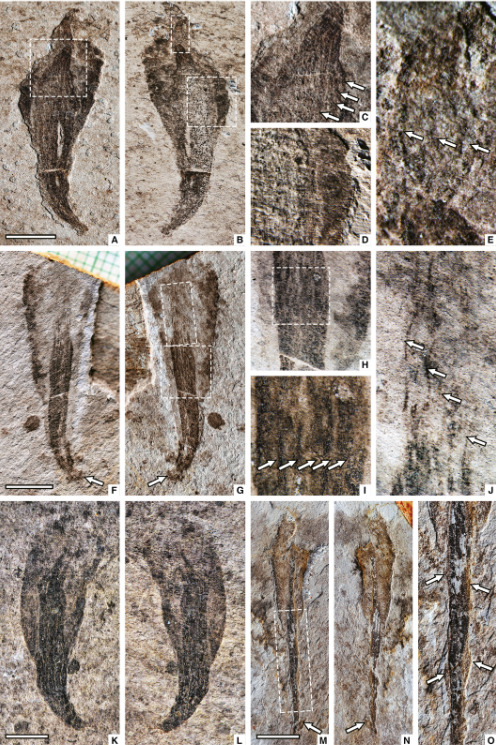
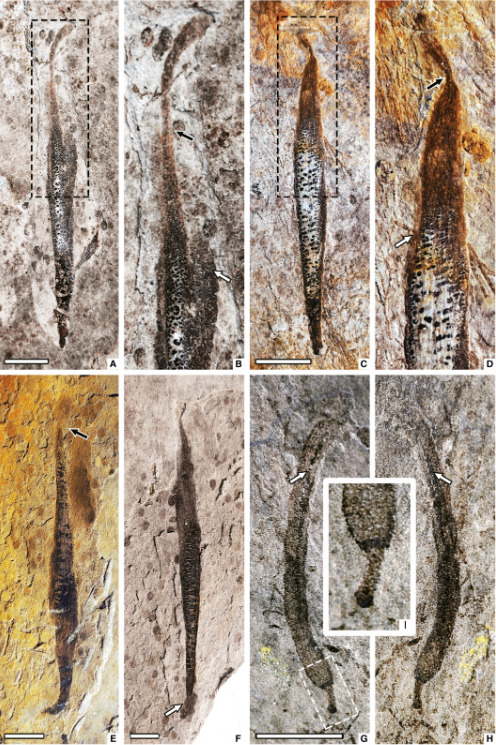
These creatures appear unrelated to lifeforms known today (except maybe cnidarians or early sessile ctenophorans?), but also to the more characteristic later Ediacaran fossils (vendobionts), making them an even more ancient mystery at the dawn of modern complex life!
https://onlinelibrary.wiley.com/doi/10.1111/pala.12242
151 notes
·
View notes
Text
... and fill the earth (2)
Dear Caroline:
This morning I finished Yglesias' book about the 1 billion Americans which you had recommended in your blog. I was actually a bit surprised that it was over - I was finishing my daily 50 minutes in the treadmill and the e-book still seemed to have 150+ pages left, but I quickly discovered they were just very badly spaced notes and bibliographical references.
I must say I found the argument pretty compelling, and assuming bona fide that the data employed is correct, it seems as the way to go. It has gone quite a long way to dispelling some of my parochial, zero-sum prejudices on population increase, even if I still retain some lingering doubts on minor aspects and details. But the whole thesis and the exposition feel quite reasonable in both of the senses of 'common sensical' and 'employing reason to analyze problems and propose solutions'.
My next take in the 'Carolingian series' will be Joseph Heinrich's The Weirdest People in the World, of which besides your review, you also talk about briefly in the second FTX podcast. I'll be giving it a go in late February / March and let you know here what I thought about it.
Right now, I am under a considerable mountain of paper. Besides our language school book club, I have joined an online EA one (this month's take is Judea Pearl's The Book of Why) and will be trying to keep up too with an asynchronous virtual book club for Eugenia Cheng's The Joy of Abstraction, about Category Theory. They both look really interesting. And finally, I filled in an application for joining EA's The Precipice Reading Group which, if admitted, is scheduled from March to May.
Talking about 'filling the earth', today I watched a PBS Eons video that blew my mind. It was about Pre-Cambrian fossils of creatures that apparently flourished in the Ediacaran Period. I imagine you might like it as well. I am definitely going to look for (yet another) book that delves into this in greater detail...
Quote:
Here, we describe a new fossil cnidarian—Auroralumina attenboroughii gen. et sp. nov.—from the Ediacaran of Charnwood Forest (557–562 million years ago) that shows two bifurcating polyps enclosed in a rigid, polyhedral, organic skeleton with evidence of simple, densely packed tentacles.
F.S. Dunn el al., extract from (the abstract of) the article on this topic, in February's issue of Nature
0 notes
Text
Ediacaran weirdos, AKA Pancake Pals
This week’s post is a slight digression from our ongoing series about animal diversity, because it features a group of mysterious fossils that may not even be animals!
I hope you’re in the mood for pancakes.

(Image: A reconstruction of an underwater Ediacaran environment, prominently featuring Dickinsonia and several Charnia along with other ediacaran weirdos. [Source])
In order to understand these weirdos, we’re going to have to take a trip way, way, back. Back before the dinosaurs, or before the first land animals, or before the first fish, or even before they started making sliced bread. A time called the Ediacaran period, when life was good, sediments stayed where they ought to be without nasty creatures crawling about in them, and pancakes roamed the seas looking for a meal.
Many of you are probably familiar with the Cambrian Explosion, which occurred about 530-540 million years ago in the Cambrian period and records the appearance of hard-bodied animal groups in the fossil record. This event really deserves its own post, or series of posts, but it’s important to remember that this event is not placed at the actual first appearance of these organisms, but rather their first appearance in the fossil record. It’s got to do with hard body parts being hip and trendy in the mid-Cambrian, and thus a bunch of animal groups all suddenly seeming to appear at once.
Key word, seeming. These animal groups all had to come from somewhere. Many groups appear in the fossil record around the same time in the Cambrian, fully formed, and so their ancestors must have lived previously. These ancestors just didn’t have very hard body parts, so we don’t easily find fossils of them. (There are several proposed reasons why animals all suddenly started making hard parts at the same time, but I won’t go into it here.)
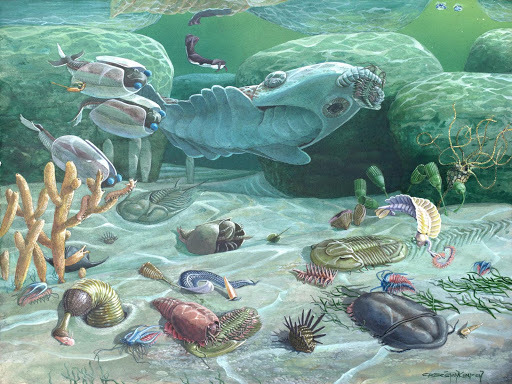
(Image: A bunch of Cambrian animals, including trilobites, Wiwaxia, and early chordates. [Source])
We’re currently living in the Phanerozoic Eon, or the age of visible life. In fact pretty much every fossil organism you can think of, from Australopithecus to T. rex to trilobites to trees, has lived in the Phanerozoic. It started 542 million years ago with the Cambrian period, just before the Cambrian Explosion, and it’s marked by the first appearance of the burrows of priapulids, AKA Penis Worms. Yes, we live in the eon of the penis worm, but what’s more important is that these burrows are maybe the earliest examples of any life form actually digging into the sediment and mixing it up, a process called bioturbation.
Prior to the Cambrian, there are practically no examples of any creatures bioturbating the sediment*, which means it was pretty much fair game for microbes to go hog wild. Because nothing could get to them.
*Okay, there are some examples. But these burrows all seem to be very simple, not very deep, and pretty much just up-and-down. Not much wriggling around going on.
This formed a unique type of sediments called microbial mats or microbially-bound sediments, in which the sediments are bound together into a sort of carpet that’s resistant to being disturbed. This sets the stage for preservation of very soft-bodied creatures, and what’s more, they’re being preserved in sand rather than in much finer-grained deposits that are usually the only things that can preserve any fine details. It’s a type of preservation that’s almost unheard of in the phanerozoic.
So, with that in mind, let’s imagine ourselves in the Ediacaran! The world has just stopped being an ice planet, and you are a horrible little rangeomorph.
What’s a rangeomorph?
Good question!

Just kidding. That’s not the end of the post, but it might as well be, because the answer to “what are these ediacaran weirdos” is “we just don’t know”. They don’t really clearly resemble any living animals.

(Image: a fossil of Dickinsonia. It’s approximately oval-shaped, and looks quilted. [Source])
Like, we really don’t know. The closest we have to knowing is that some bio-geo-chemical data has indicated preservation of fossil cholesterols, which narrows it down to “they are animals, or fungi, or something that’s a close relative of animals and fungi”. They’ve been suggested to be sponges, or cnidarians (jellyfish and friends), or bilaterians, or even giant placozoans, or a TON of other things. My personal favourite idea is that they’re giant single-celled organisms similar to modern monothalameans, and that they’re not animals or fungi but rather their own little group (Many of these quilted weirdos have been grouped together in a group called petalonamae, which is sometimes called vendozoa; they’re pretttty much the same thing).
So, without further ado, here’s a little who’s-who of some of the more well-known ediacaran weirdos! I’ve already shown you Dickinsonia, the classic little pancake whom we all love. Like many of these vendozoans, it comes from Australia. The very largest get up to 1.4m long! More typically, though, they’re on the order of a few centimetres. Sometimes they’re very long, but they’re never very thick, and they have a weird “quilted” appearance.

(Image: Glide symmetry in a fossil of Charnia and in cartoon leaves.)
Although Dickinsonia appears to be symmetrical at first glance, that’s not quite true. Rather than being truly symmetrical, it has what’s called glide symmetry—i.e. the body segments are mirrored and then moved forward a little, so it’s not precisely symmetrical. This is pretty common for vendozoans.

(Image: A group of Charnia, frond-like quilted organisms that stand up, looking a bit like feathers. Image by Nobu Tamura [Source])
Another significant group of ediacaran weirdos are the rangeomorphs, of which the most famous is Charnia. It maintains the quilted appearance of Dickinsonia, but stands straight up, with a sort of anchor-point holding it to the ground. Charnia fronds are typically about 10-20cm long, but some specimens that are over 2m long have been reported.

(Image: Swartpuntia, a rangeomorph that looks like three Charnia clipped through each other badly. Image by @alphynix—go follow them if you’re not already, they do great art!)
Other rangeomorphs, like Swartpuntia, have between three and six-fold symmetry, and so look more like a lemon-juicer. It also has a name that’s very fun to say.
Swartpuntia and other rangeomorphs are pretty significant in that they represent possibly the earliest tiered ecosystems of non-microscoping life forms! While things like Dickinsonia were crawling around on the ground, rangeomorphs were taking advantage of different resources by growing tall and frondy.

(Image: A fossil of Spriggina, a flattened, elongate, vaguely phallic impression fossil. [Source])
There’s also Spriggina, which—surprise!—has been a source of debate as to what it is. It’s variously been proposed to be a worm, a trilobite relative, or a vendozoan. It has glide symmetry, though, so I’m grouping it with vendozoans here.
One thing all these vendozoans have in common, besides glide symmetry and being impressions on rocks, is that there’s very little apparent internal structure. Whether this is solely an artefact of preservation is up for debate, but there is not clearly a mouth, or gut cavity, or reproductive organs, or anything like that. It’s assumed they fed by osmosis, either by moving along the seafloor feeding on microbes in the sediment (if they were flat like Dickinsonia), or by consuming floating microbes (if they were frondy, like Charnia). It’s also assumed they reproduced asexually via fission or budding.
Whatever the vendozoans were, their time was not short lived. Between the first and last of these ediacaran weirdos, almost 70 million years passed. That’s more time than between us and T. rex! During that time they survived an ice age, but they didn’t survive the start of the Cambrian. No definite vendozoan fossils are known from the phanerozoic, and it’s pretty widely thought that the start of more intense bioturbation probably destroyed the microbial mats they relied on. So these days we have to make our own pancakes.
510 notes
·
View notes
Text
Strange Symmetries #03: Eerie Early Echinoderms
Represented today by starfish, brittle stars, sea urchins, sea cucumbers, and crinoids, the echinoderms have a characteristic five-way radial symmetry that makes them barely even recognizable as bilaterians. Their true ancestry is only revealed by their genetics and their larvae, which still retain bilateral symmetry – and the way they metamorphose into adults is bizarre, essentially growing a whole new radial body from within the left side of their larval body.
(Sea cucumbers and sand dollars are superficially bilateral as adults, but evolved this secondarily on top of their existing radial symmetry. And some adult echinoderms like starfish also seem to retain a little bit of "behavioral bilaterism", generally preferring to move with a specific arm always acting as their "front" end.)
The first known echinoderms appeared in the fossil record during the early Cambrian, about 525 million years ago, but the common ancestor of the whole group probably actually originated a few tens of millions of years earlier in the mid-to-late Ediacaran. Early echinoderms seem to have started off as flattened animals that sat on the seafloor filter-feeding, and with this largely immobile way of life their bodies started to shift into asymmetry, no longer constrained by the locomotory advantages of being bilaterally symmetric.
In fact, for these early sedentary filter-feeders being radial was actually much more advantageous, able to distribute sense organs all around their bodies and grab food from any direction without having to reposition themselves, converging on the lifestyle of non-bilaterian cnidarian polyps. The evolutionary transition from bilateral to asymmetrical to pentaradial seems to have happened incredibly quickly during the Cambrian Explosion, and all modern echinoderms probably evolved from a group called the edrioasteroids, maintaining their new base body plan even when they later began taking up more mobile lifestyles again.
But during the process of all that some very alien-looking lineages split off at various stages of anatomical weirdness.
Stylophorans had asymmetrical bodies with a single feeding arm at the front, and varied from irregular boot-like shapes to almost bilateral heart shapes depending on their specific ecologies. The highly asymmetrical forms were probably spreading their weight out over soft soupy mud in quiet waters, while the more bilateral forms may have been more streamlined to deal with stronger water currents.
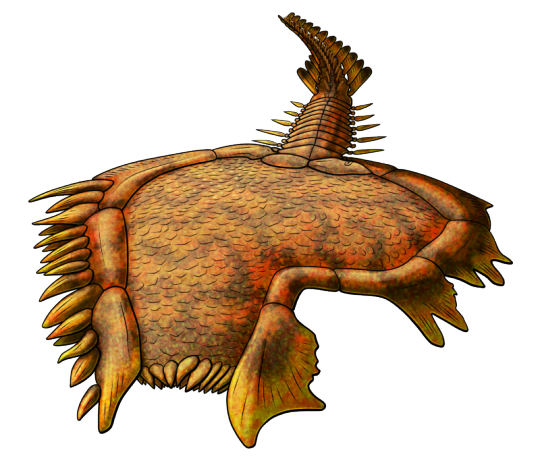
Sokkaejaecystis serrata was a stylophoran that lived during the late Cambrian, about 501-488 million years ago, in what is now South Korea. It was tiny, only about 1cm long (~0.4"), and its boot-shaped body was surrounded by spines and flanges that spread out its surface area and probably also made it much more awkward for small predators to attempt to eat.
———
Meanwhile the solutes started off as immobile animals living attached to the seafloor via a stalk-like appendage. But fairly early in their evolution they switched to a more active mode of life, modifying their stems into tail-like "steles" that were used to push themselves along.
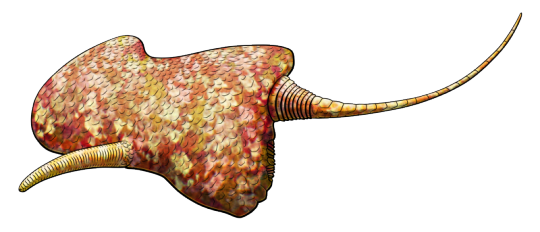
Maennilia estonica lived in what is now Estonia during the late Ordovician, about 450 million years ago. It was quite large for a solute at about 12cm long (~4.7"), with a sort of vaguely-trapezoidal body, a short feeding arm, and a long thin stele.
Both of these strange early echinoderm lineages were surprisingly successful, surviving for a good chunk of the Paleozoic Era alongside their more familiar radial relatives. The solutes lasted until the early Devonian about 400 million years ago, and the stylophorans continued all the way into the late Carboniferous about 310 million years ago.
———
NixIllustration.com | Tumblr | Twitter | Patreon
#science illustration#strange symmetries#paleontology#paleoart#palaeoblr#sokkaejaecystis#stylophora#maennilia#soluta#echinoderm#ambulacraria#deuterostome#bilateria#art#eldritch echinoderms#go home evolution you're drunk
506 notes
·
View notes
Photo

Cnidarians – a group of animals that includes modern corals, sea anemones, sea pens, jellyfish, hydra, and a couple of parasitic forms – are one of the most ancient animal lineages, originating at least 580 million years ago in the Ediacaran period.
Actual identifiable fossils of cnidarians that old are incredibly rare, however, and until now there was only one example – the small polyp-like Haootia from Canada.
But a second definite Ediacaran cnidarian has now been described: Auroralumina attenboroughii.
It was discovered in Charnwood Forest, England, in the very same site where the first recognized Precambrian fossils were found in the 1950s. About 20cm tall (~8") it dates to around 560 million years ago and was made up of a pair of forking stiff-walled tubes which expanded into wide four-sided goblet-like shapes full of stubby tentacles. These densely-tentacled crowns would have been used to capture tiny planktonic organisms from the water around it, making it the current earliest known example of a predatory animal.
The one known fossil specimen has an incomplete base, so it's uncertain if this was actually the full life appearance of Auroralumina or if it was even larger with more branches and goblets. And although it was preserved in deep-water sediments, it appears to have originated from much shallower waters, being swept down into the depths during a volcanic eruption.
While it superficially resembled a sea anemone, details of its anatomy suggest it was actually much closer related to medusozoans, having similar traits to the immobile polyp stage of the jellyfish life cycle. Its four-way symmetry and boxy shape may also link it to the enigmatic conulariids.
It's not clear if it was able to bud off swimming medusa stages like its modern relatives – that might be an evolutionary innovation that came along later – but it at least shows that a basic medusozoan body plan was already in place around 20 million years earlier than previously thought.
———
Nix Illustration | Tumblr | Twitter | Patreon
#science illustration#paleontology#paleoart#palaeoblr#auroralumina#medusozoa#cnidaria#invertebrate#ediacaran#art
254 notes
·
View notes
Text
It's March, and that means it's time for Cambrian Explosion Month!
(…Part 1, because this is a topic I can't possibly fit comfortably into just 31 days. Part 2 will happen later this year.)
The start of the Paleozoic Era 541 million years ago is marked by what's become known as the "Cambrian explosion" – a time of rapid evolutionary diversification when representatives of most known animal phyla first appear in the fossil record.
For a long time some of the creatures from this period were seen as mysterious alien-looking fossil weirdos, barely seeming to make anatomical sense and unable to be classified into any known animal groups. Some paleontologists even proposed they represented an entirely separate branch of the animal evolutionary tree, regarding them as "failed experiments" that had left no living relatives at all.
But, slowly, we've been piecing together the evidence and figuring out their relationships, studying exceptionally well-preserved fossils and the genetic connections between modern-day animals. And gradually many of the bizarre fossil species are starting to find their places in the tree of life as evolutionary "cousins" of modern groups, novel early branches of more familiar lineages that are giving us more insight into their origins.
It isn't clear what actually prompted the sudden innovation of the Cambrian Period, but it was probably a combination of various environmental and ecological factors – including changes in oxygen levels, the formation of the ozone layer, early burrowing animals altering the aeration and chemistry of the seafloor, the development of biomineralization, and increasingly complex "arms races" between predators and prey.
It's also looking increasingly likely that it wasn't really an isolated "explosion" at all, instead being one of multiple pulses of rapid diversification that started further back in the Ediacaran Period.
———
Cambrian Explosion Month #01: The Explosion Before The Explosion
An evolutionary burst known as the Avalon explosion around 575 million years ago produced a range of weird unidentifiable fossil creatures – the strange Ediacaran biota – many of which seem to defy classification and have often been considered to be early "failed experiments" in multicellular life.
…That sounds awfully familiar, doesn't it?
Our understanding of the Ediacaran has recently been echoing our history of understanding the Cambrian, and we've even been starting to figure out that some of these bizarre creatures weren't quite so alien as they first seemed. A few of them are now revealing their evolutionary connections to early animal life, and showing that some groups go back much further than previously thought.
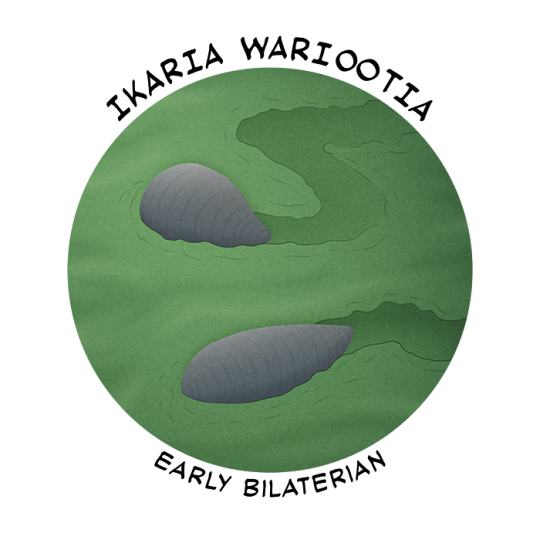
Ikaria wariootia was a tiny worm-like creature the size of a grain of rice, up to 7mm long (0.25"). Discovered in the South Australian Ediacara Hills fossil site that gives the entire time period its name, and dating to 555 million years ago, it was probably an early bilaterian animal that burrowed around in thin layers of sand on the seafloor.
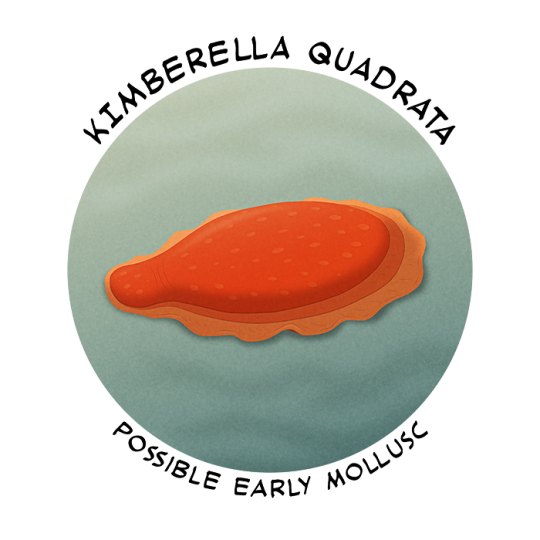
Kimberella quadrata was another early bilaterian known from Australia and northwest Russia, living around 558-55 million years ago. It was about 15cm long (6") and vaguely resembled a slug, and it may have actually been a very early member of the mollusc lineage – some interpretations consider it to have had a radula-like feeding structure and a leathery "shell".
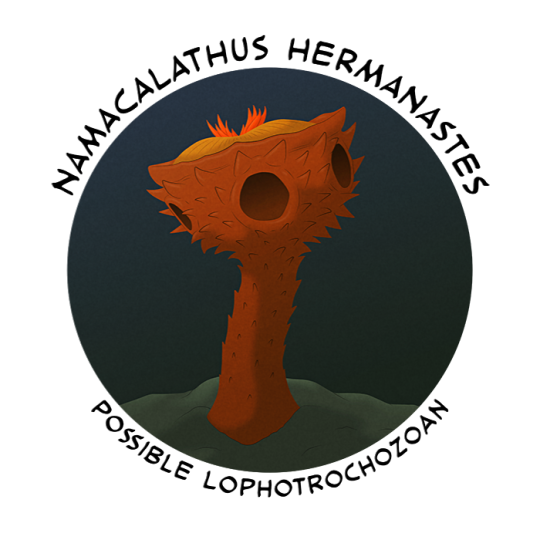
Namacalathus hermanastes is known from Namibia 549-542 million years ago. About 5cm tall (2"), it was an odd-looking creature shaped like a "cup on a stalk", lightly calcified and covered in spines, with six "holes" around the outside of its body. While in the past it's been compared to cnidarian polyps, more recent studies suggest it was actually an early lophotrochozoan – related to the ancestors of annelid worms, molluscs, bryozoans, and brachiopods.

Yilingia spiciformis was a segmented worm-like bilaterian that may have been related to either annelids or panarthropods. Living in South China during the late Ediacaran and earliest Cambrian, between 551-539 million years ago, this animal reached up to 27cm long (10.5") and was found fossilized at the end of its own trackway.
———
Nix Illustration | Tumblr | Pillowfort | Twitter | Patreon
#science illustration#paleontology#paleoart#palaeoblr#cambrian explosion 2021#ediacaran#avalon explosion#ikaria#kimberella#namacalathus#yilingia#bilateria#eumetazoa#animalia#lophotrochozoa#mollusc#art#long post
285 notes
·
View notes
Photo
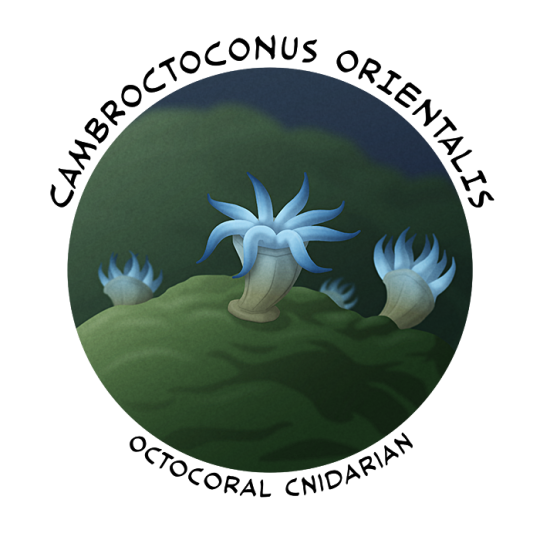
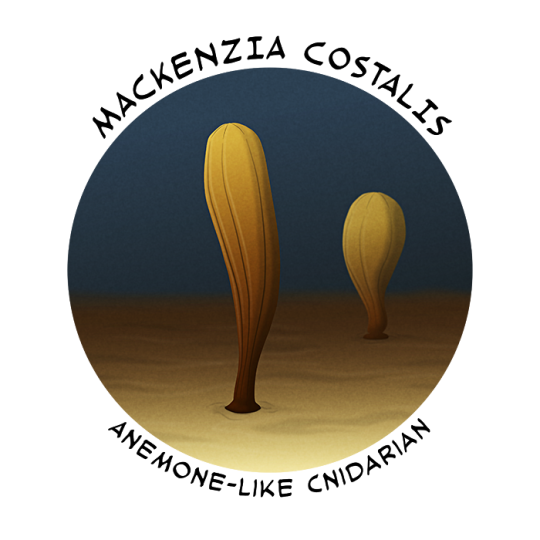
Cambrian Explosion Month #05: Phylum Cnidaria – Anthozoa
Cnidarians are a diverse group that includes modern corals, sea anemones, sea pens, jellyfish, hydra, and even some parasitic forms. They're the closest relatives of bilaterians in the animal evolutionary tree, and their ancestry goes back at least 560 million years into the Ediacaran Period, with the polyp-like Haootia being one of the earliest definite cnidarian fossils – and molecular clock estimates suggest the group might have actually originated much much earlier than that, possibly as much as 740 million years ago.
The anthozoan lineage of cnidarians (corals, anemones, and sea pens) spend their adult lives as polyps attached to the seafloor, either solitary or colonial, and since many lineages have hard calcium carbonate skeletons their fossil record is generally much better than that of the soft-bodied medusozoan jellyfish.
While corals are major contributors to reef ecosystems in modern times, back during the Cambrian they were actually rather rare. The weird little archaeocyathan sponges were the main reef-builders in the early-to-mid Cambrian, and after their decline reefs were mainly formed by algae and other types of sponges.
But, sometimes, growing among these reefs were also some tiny Cambrian corals.
Cambroctoconus orientalis is known from fossil reefs in Eastern China dating to about 505-500 million years ago. Around 1cm long (0.4"), it had a cup-shaped skeleton and preferentially grew in sheltered "crypts" – overhangs, gaps, and small caves in the reef framework.
It was originally thought to be a very early type of cnidarian, part of a coral-like stem lineage separate from true corals and other anthozoans, but discoveries of several other species of Cambroctoconus in Kyrgyzstan, South Korea, and Greenland have better preserved elements of its anatomy and allowed for a revised classification. Based on its eight-way symmetry and distinctive skeletal pores, it seems to have actually been an early octocoral.
———
The strange bag-like Mackenzia costalis from the Burgess Shale (~508 million years ago) was initially classified as a sea cucumber when it was first discovered in the early 1900s. Later, more fossils and studies in the late 1980s and early 1990s led to it being reinterpreted as a cnidarian, potentially an early member of the sea anemone lineage.
Up to 20cm tall (8"), it lived attached to hard surfaces on the seafloor standing upright with its mouth at the top. It had a large gut cavity, the surface of its body was folded into 8-10 vertical ridges, and it doesn't seem to have had any tentacles. It probably fed on plankton or suspended organic particles, but it's not clear how it actually did so – possibly it expanded and contracted to move water in and out of itself.
———
Nix Illustration | Tumblr | Pillowfort | Twitter | Patreon
#science illustration#paleontology#paleoart#palaeoblr#cambrian explosion 2021#cnidaria#anthozoa#cambroctoconus#octocoral#coral#mackenzia#actinaria#sea anemone#eumetazoa#animalia#art#...or (very speculatively) maybe mackenzia was an ambush predator#vaguely mimicking a sponge#little animals crawl in looking for a nice safe refuge#then SHLORP they get trapped and eaten
101 notes
·
View notes
Photo
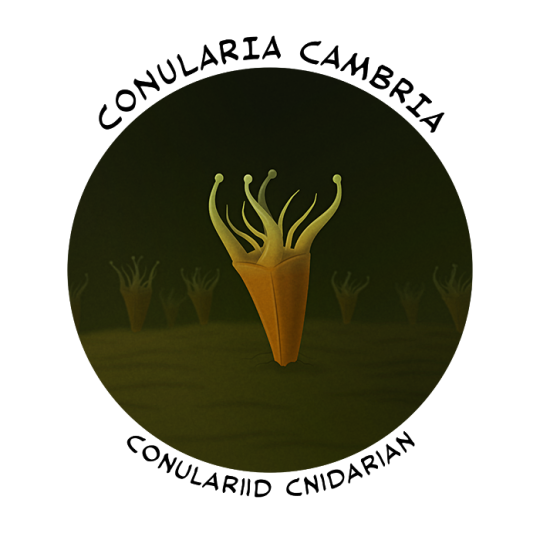
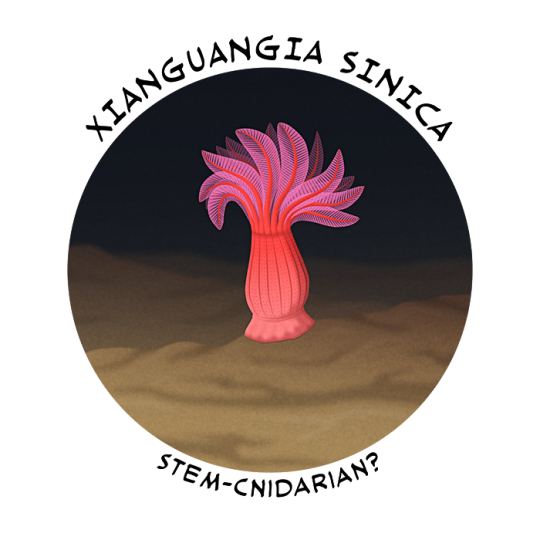
Cambrian Explosion Month #07: Phylum Cnidaria – The Weird Ones
Odd shell-like structures that resemble angular ribbed cones with four-way symmetry appear in the fossil record starting around the mid-to-late Cambrian (with a possible Ediacaran record).
Known as conulariids, these fossils are so distinctive and different from anything else that for a long time their evolutionary affinities were unknown, and they were considered to be a "problematic" group. But in recent years they've been identified as being cnidarians, generally thought to be close relatives of modern stalked jellyfish.
Conularia cambria was one of the earliest definite conulariids, known from the states of Wisconsin and Minnesota, USA, and dating to the Late Cambrian (~490 million years ago). Up to about 5cm long (2"), its shell lacked the ribbed texture of most other conulariids but it would have otherwise looked very similar to later species – living attached to the sea floor by the pointed end of the cone, with tentacles protruding from the wider end at the top.
Conulariids were also unique among cnidarians for producing pearls inside their shells similar to those found in molluscs.
And despite being relatively rare and low-diversity, conulariids were a surprisingly long-lived group. Not only did they last throughout the rest of the Paleozoic Era, but they then survived the Great Dying mass extinction at the end of the Permian and only went completely extinct at the end of the Triassic, about 201 million years ago.
———
Another unusual fossil from the mid-Cambrian Chengjiang biota in southwest China (~518 million years ago) might have been a cnidarian. Xianguangia sinica was a tiny 2cm tall (0.8") sea anemone-like animal with a cylindrical body, an attachment disc at the bottom, and an upper whorl of around 16 tentacles with feather-like extensions that suggest it was a filter-feeder.
It's generally considered to be a "stem-cnidarian", part of an extinct early lineage that has no close modern relatives. It might represent a weird offshoot that experimented with a different body plan and feeding strategy than the rest of the group, or it might be a late-surviving example of what ancestral cnidarians originally looked like.
But other studies have instead linked it with potential ancestors of comb jellies, so its classification is still rather uncertain.
———
Nix Illustration | Tumblr | Pillowfort | Twitter | Patreon
#science illustration#paleontology#paleoart#palaeoblr#cambrian explosion 2021#conulariida#conularia#staurozoa#medusozoa#cnidaria#xianguangia#stem-cnidarian#maybe#eumetazoa#animalia#art
92 notes
·
View notes
Photo

Unsolved Paleo Mysteries Month #17 -- Enigmatic Ediacarans
Although Precambrian fossils have been known since the mid-1800s, the overwhelming belief among 19th and early 20th century scientists that complex life couldn’t have originated that early meant such discoveries either weren’t taken seriously or were forcibly assigned to a Cambrian age. It wasn’t until the discovery of Charnia in the 1950s that views began to change.
(Or, rather, the second discovery of Charnia, since the schoolgirl who first found it wasn’t taken seriously either.)
Since then, a wide variety of strange soft-bodied fossils have been identified from over 30 different localities around the world, on every continent except Antarctica, dating to ages from over 600 to 542 million years ago. They’re now known as the Ediacaran biota, after the Ediacara Hills in Australia where some of the most famous examples have been found.
A few show possible similarities to known groups, but we still don’t know what sort of lifeforms most of them they actually were. Animals, fungi, algae, foraminifera, microbial colonies, or lichens have all been proposed -- but they might also belong to a completely unique kingdom or phylum, a “failed experiment” in multicellular life with no living descendants.
And they’re gradually turning out to be not nearly as “simple” as once thought, showing evidence of their own thriving ecosystems and evolutionary specializations -- which makes their sudden disappearance at the end of the Ediacaran Period all the more mysterious.
Tribrachidium has been found in Australia, Ukraine, and Russia (558-555 mya), grew up to 5cm in diameter (2″), and shows unusual tri-radial symmetry. Affinities to both cnidarians and echinoderms have been suggested, but no classification has really stuck. Recent 3D modelling and fluid dynamic studies reveal its shape was adapted to direct water currents into the nooks between its “arms”, allowing it to feed on suspended organic particles.
Yorgia is known from Australia and Russia (~555 mya), and appears to be a transitional form between two other ediacarans, Dickinsonia and Spriggina. It has what appears to be a “head” end with an asymmetrical lobe, and a segmented body in a glide reflection pattern, growing up to 25cm long (10″). Trace fossils from its feeding strategy have also been found -- chains of imprints over seafloor microbial mats, where it moved from spot to spot and “grazed” with the entire underside of its body.
Fractofusus is somewhat older (575-560 mya) and perhaps even stranger. Discovered in Canada in 1967, it was known only as “the spindle organism” for 40 years before being finally named in 2007. Its 40cm long form (16″) shows fractal self-similarity, made up of frond-like elements that branch even further again and again and again, creating a large surface area relative to its internal volume that may have been used to directly absorb nutrients from the surrounding seawater. It also seems to have been capable of reproducing in two different ways -- producing both water-borne offspring and stolon-like clones of itself.
#unsolved paleo mysteries month#science illustration#paleontology#paleoart#palaeoblr#ediacaran#tribrachidium#yorgia#fractofusus#precambrian#art#go home evolution you're drunk
195 notes
·
View notes